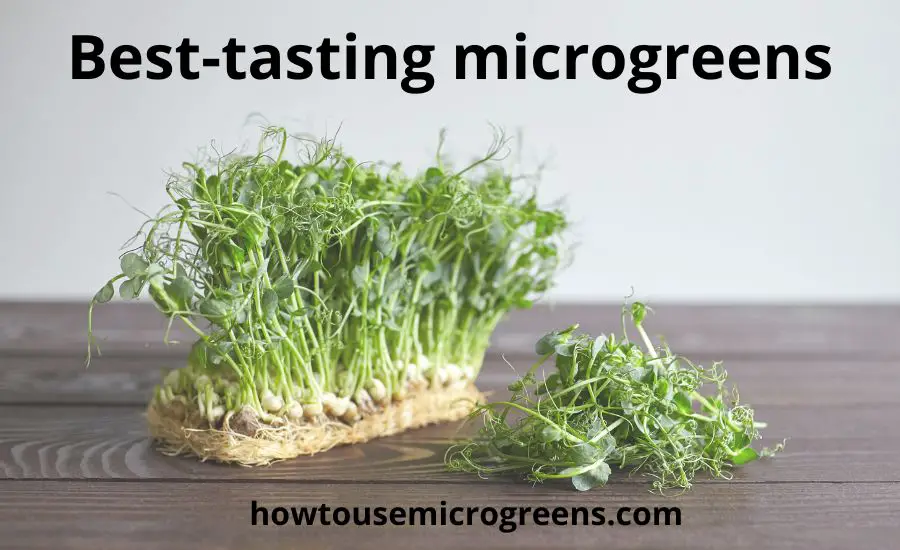Have you ever experienced a situation when a single herb changed a dish completely, transforming it from something trivial and bland into a piece of art? Probably. Many greens have this kind of magic. Nowadays, standard greens are often substituted with microgreens, which look cute and grow faster. As microgreens are becoming more and more popular, folks often ask about the best-tasting microgreens.
Let me take you for a quick tour of the exciting world of little plants, which are miniature copies of their big siblings, but retain all the amazing qualities. And again, they are cute.
I don’t have any winners in my top ten list. Why? The answer is simple: it tastes different. Some of us associate the word ‘tasty’ with sweetness. For them, the best microgreens will have a sweet taste.
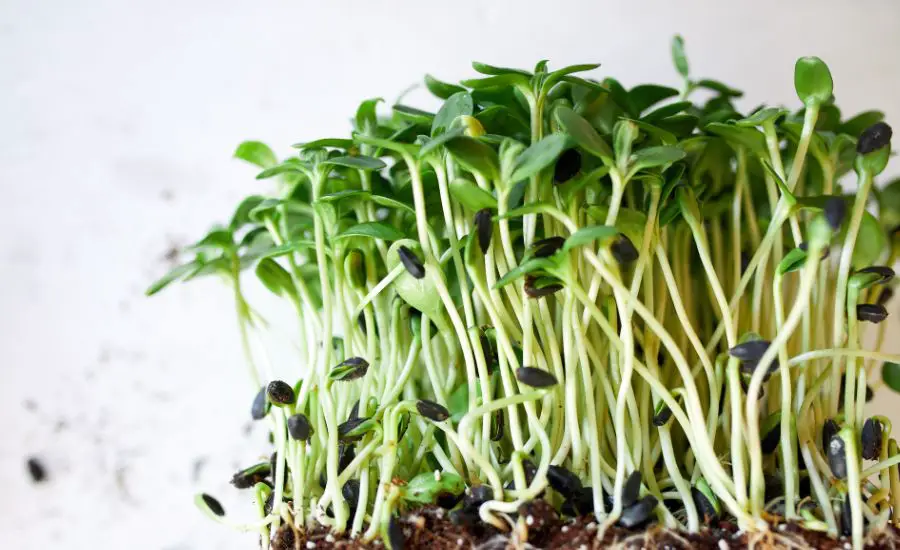
For other folks like me, a spicy flavor is an undisputed winner.
Hence, you are getting the best 10 microgreens, providing distinct flavors and aromas that will make all your dishes unique.
Contents
Best tasting microgreens: top list
Here is my list of the microgreen champions, each of them mouthwatering.
Arugula microgreens
The mild, yet slightly spicy arugula microgreens taste fantastic, which makes them perfect for salads. Add to that a beautiful green hue, and you won’t be able to resist them whenever you make a bowl of green salad.
My personal favorite is a dish of scrambled eggs generously sprinkled with arugula microgreens. It is simple and elegant.
If given enough lighting, arugula microgreens can be ready for harvesting after one or two weeks with the appearance of the first lovely leaves.
A convenient addition: you don’t have to soak seeds.
But be careful when watering arugula. These microgreens aren’t tolerant to excessive water, so measure their amount with caution.
Benefits
A rich source of lutein, this microgreen will protect your body from free radicals. Besides, it’s rich in vitamin EE, as well as A and C.

Basil microgreens
This unique and essential herb of Mediterranean cuisine has the same unforgettable flavor as its larger siblings.
Basil microgreens are also exceptionally flavorful with spicey and sweet tones in the taste and aroma. Depending on the sort, basil microgreens taste a little different.
After only a couple of weeks, generous watering, and a warm environment, basil microgreens will gift you with their delightful leaves, which you can add to pasta or salads, or make the best Ligurian pesto.
Benefits
Including basil microgreens in your diet will enrich it with such vitamins as A, C, and K. Apart from that, you will receive essential Omega acids, which will make you not only healthy but beautiful as well. Calcium, magnesium, and iron are other components of the precious herb.
Beet microgreens
These lovely microgreens with bright red stems take a little longer to grow. You may have to wait for 10 to 20 days before the beet seeds turn into full-grown microgreens. But they are worth the wait.
Their sweet and slightly earthy flavor and tender texture will complement any green salad, splashing it with a touch of bright red and creating a gorgeous ensemble. Avocado toast with these greens is gorgeous.
They love the outdoors and natural sunlight, although can be grown inside, too. Interestingly enough, if grown outside, their sweet flavor is more intense.
Benefits
Beet greens are famous for containing a large amount of vitamin K, as well as such critical elements as iron, calcium, and manganese. One of the best-tasting microgreens is also a great health guard.
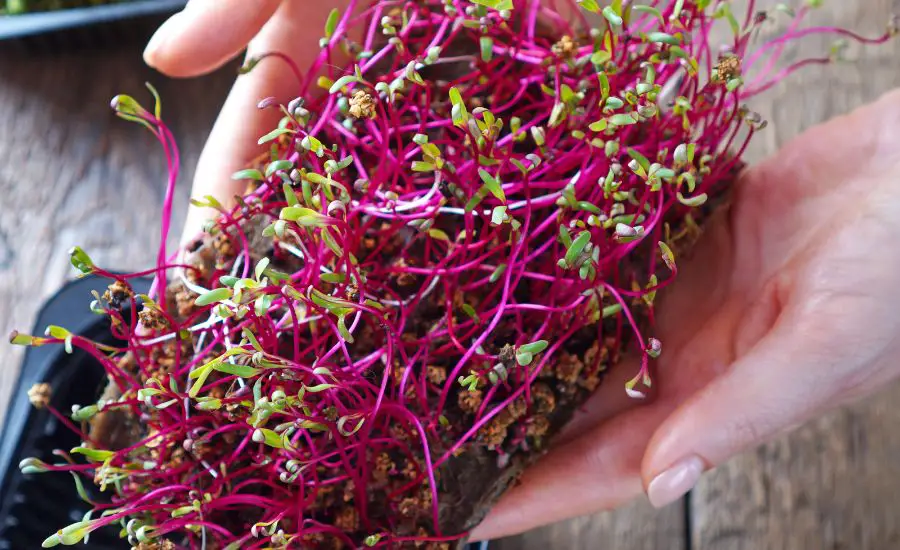
Broccoli microgreens
A slightly spicey flavor of broccoli microgreens combined with a hint of bitter taste and their own unique aroma makes them one of the best-tasting microgreens.
Add here super fast-growing (for certain kinds of broccoli microgreens, it’s a week), and you will get a plant with an exceptional and delicious taste in no time.
Turkey and beef sandwiches and any green salad will benefit from such an ingredient. Broccoli microgreens are a treasure for vegans, as they can provide you with an abundance of plant-based protein.
Benefits
A source of vitamins A and C, they will boost your immune system, making it harder for an illness to cripple you. Zinc and potassium, as well as iron and calcium, are essential elements for our health, and they can be found in broccoli microgreens in abundance.
Cress microgreens
If you are a fan of cress, you’ll appreciate its microgreen variety, too. Its slightly spicy flavor with a peppery hint has a unique fresh aroma. It brings an edge to the salad of milder-tasting greens, making it interesting.
A beef sandwich with cress microgreens will taste delicious, too.
In no time (9-12 days), you’ll be able to harvest these microgreens with distinctive and bold flavors.
Just give them enough light and be careful not to over-water your cress, and you’ll have one of the best-tasting microgreens shortly.
Benefits
As with all the other microgreens we are describing here, cress is a wonderful bodyguard for your health. Apart from containing a large number of antioxidants, it will also provide you with vitamins B, A, and C. Besides, it’s one of the most nutritious salad greens.
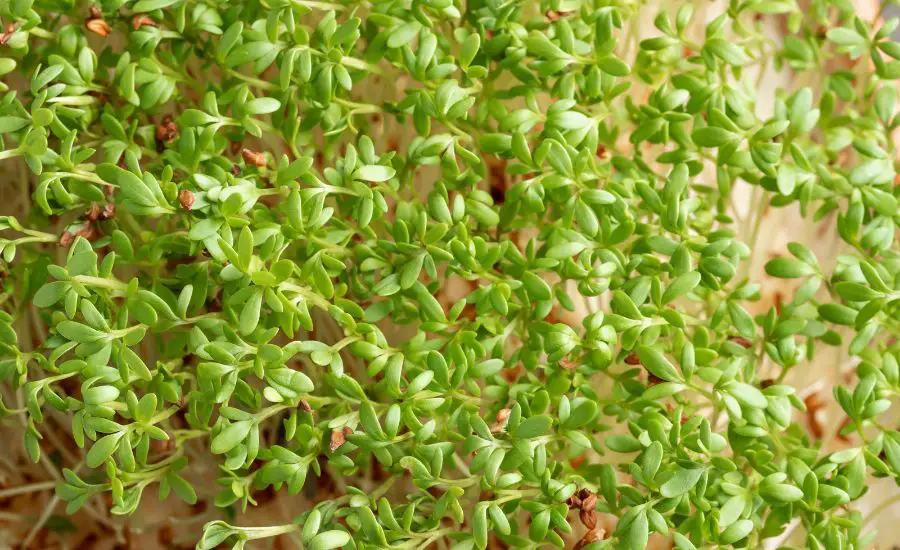
Kale microgreens
If you are keen on growing microgreens, consider kale. Most microgreens taste good, and kale is no exception. It has a mildly sweet and earthy flavor. It’s very filling, as it contains plenty of nutrients.
I love adding it to savory dishes like pasta and stews.
Growing kale is not a bother and will take you from one to two weeks before harvesting. They are not picky in terms of growing conditions, and even a newbie gardener can cope with a task.
Benefits
Kale microgreens can provide you with a supply of vitamins K, C, and B6, as well as fiber, folate, and manganese, all critical for our body to function properly.
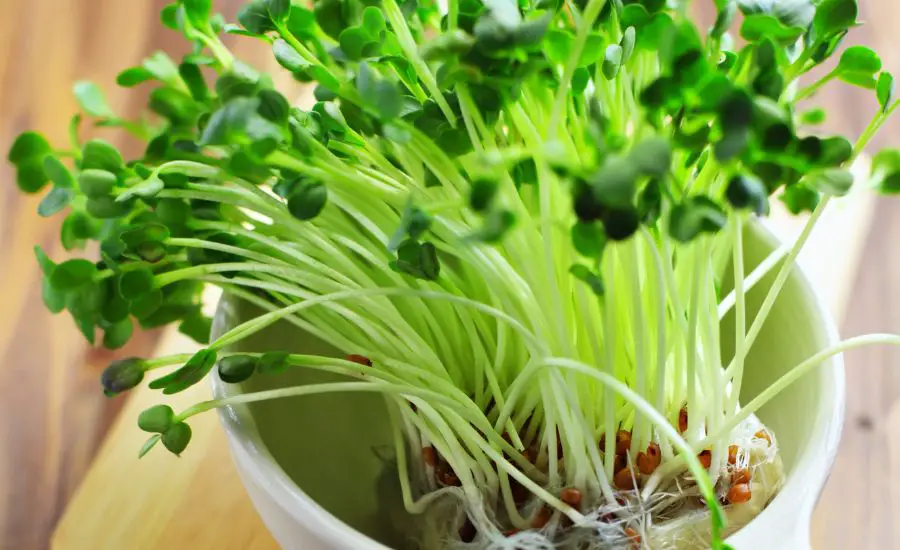
Mustard microgreens
We all know mustard, which is an essential part of most meals in the form of delicious paste. Why not try a different part of the plant? We are used to crushing seeds, but trying mustard microgreens will open an entirely new world of spice for you.
The spicy aroma of mustard microgreens and their fresh and zesty taste make them a fantastic garnish for cooked dishes like soups or stews.
You can eat microgreens raw in salads, too. Add some spice to your life.
Growing your own microgreens is a great idea, but mustard microgreens are not only one of the easiest to grow but the fastest ones as well. You may be able to start harvesting these charming greens after a week. And no special treatment is needed, just plenty of sunlight and water.
Benefits
Mustard greens gift us with an abundance of vitamins, including A, E, and K, and a lot of microelements that will work for our health benefits, like thiamin, phosphorus, and calcium.
Pea microgreens
Even the biggest fans of spicy greens will be charmed by the sweet and delicate taste of pea shoots. Succulent and tender, they are a mouthwatering ingredient in salads and sandwiches. You can use them as a garnish, too. They are lovely on the plate.
Pea shoots grow taller compared to other microgreens but still remain miniature. If you grow microgreens, you certainly know that pea shoots are not complex at all. And fast. Ten days of growing — and you are blessed with the first leaves. Even if you are still an inexperienced gardener, you’ll have no issues with pea shoots.
Mature microgreens growers recommend soaking the seeds (organic seeds preferably) for 24 hours before sowing.
Benefits
Health benefits from pea microgreens are fantastic, which can be said about all microgreens. As for the peas, they are a treasure trove of vitamins C, A, and E. Besides, they will supply you with precious Omega-3 fatty acids.
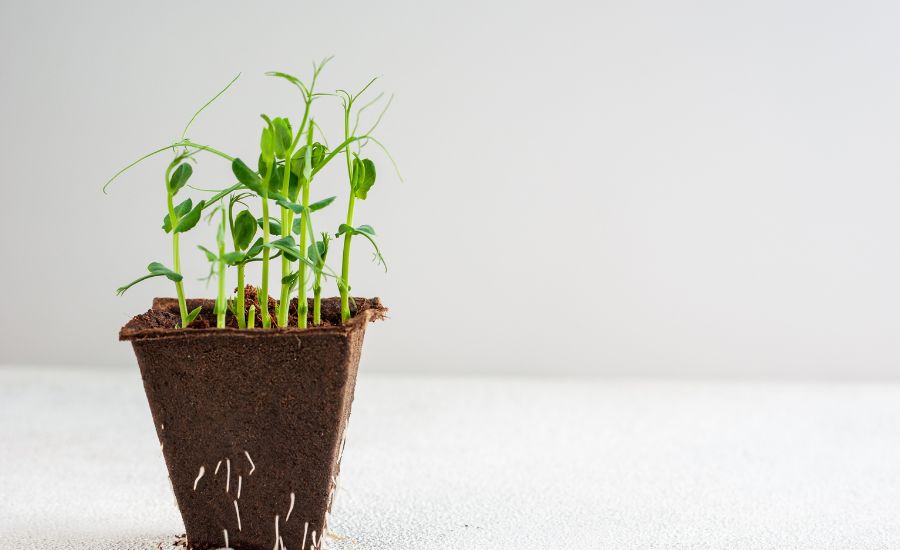
Radish microgreens
If you want to spice your life a little, try growing radish microgreens. These little guys pack serious heat. But it’s not a simple pepper-like taste, it’s much more nuanced and interesting.
There is sweetness in it, which, together with a fresh aroma, creates a unique and delicious ensemble. It will boost the taste of any salad and enrich the flavor of a savory dish.
As with their larger siblings, radish microgreens have several varieties. They have some taste nuances, but no matter which kind, all radish microgreens are delicious additions to your daily diet.
They are almost effortless to grow and will provide you with the first crops in no time (1 week on average).
Benefits
Radish microgreens inherited their beneficial qualities from their bigger siblings and are packed with vitamin E. Other vitamins are also present, including A and C. Phosphorus and zinc, which are critical for our body’s proper functioning, are also the components of radish microgreens.
Sunflower microgreens
Growing microgreens is easy, growing sunflower microgreens is super easy. They are not high maintenance at all, and after only 7-10 days you can enjoy their unique nutty taste which has become a distinctive feature of the plant.
I love adding them to my smoothies. They give it ‘meaning’ and make you feel well-fed after a mere glass of the beverage. Sunflower microgreens will enhance the flavor of any green salad or sandwich, too.
As for the growing tips, I recommend soaking the seeds before sowing. Give them 8-10 hours, and they are ready to be put in the soil.
Benefits
Vitamin K, as well as A and C in sunflower microgreens, will gift you with multiple health benefits and boost your immune system. Amino acids, together with Omega-3 and 6 fatty acids, which sunflower microgreens have in abundance, are a critical part of a healthy lifestyle.

Serving solutions
Before finishing this article, I would like to give you some general recommendations for incorporating microgreens into your daily diet.
First and foremost, microgreens work wonders in salads. They enhance the taste, bring new and unique flavors, and turn a simple dish into an eloquent ensemble of flavors.
Also, microgreens are an excellent garnish for savory dishes.
Play with the flavors and create extraordinary stews and soups.
Another great solution for microgreens is sandwiches. Here, you can use all your creativity and make endless combinations of tastes and aromas.
And the last but not least recommendation: why not use microgreens instead of their standard siblings? They taste similar but look cuter… it’s worth a try.
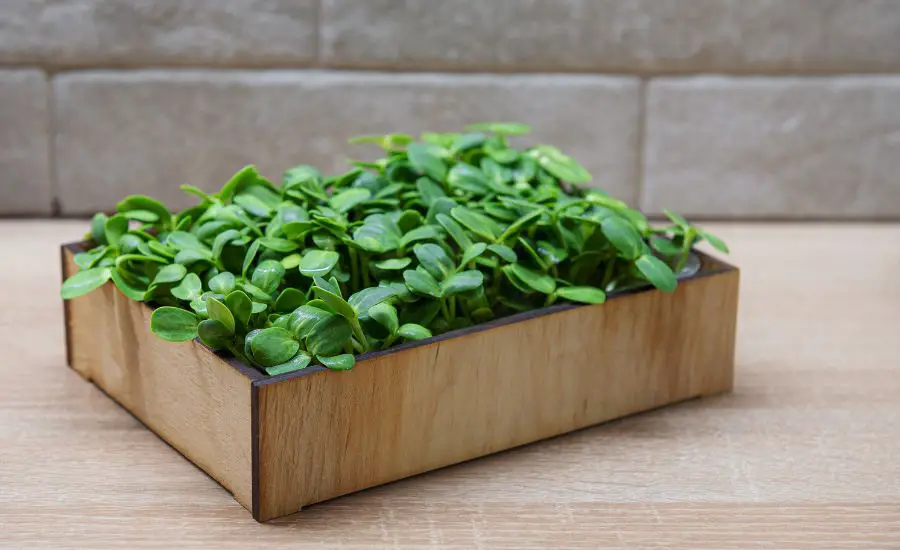
Conclusion
Microgreens are delicious and healthy products worth adding to our diet. Besides, they are so easy to maintain. Try the easiest microgreens to grow and enjoy healthy and tasty treats while having fun during the whole process.
FAQ
What is the tastiest microgreen?
Tastes differ, but lots of folks think that pea, radish, and cilantro microgreens are the most delicious and also the easiest microgreens to grow.
What are the sweetest tasting microgreens?
Pea microgreens are probably the sweetest microgreens.
What is the healthiest microgreen to eat?
All microgreens are treasures in terms of vitamins and elements essential for proper body functioning.
How do you make microgreens taste better?
You can cook them for a bit. For example, cilantro microgreens acquire interesting taste nuances when cooked slightly.

